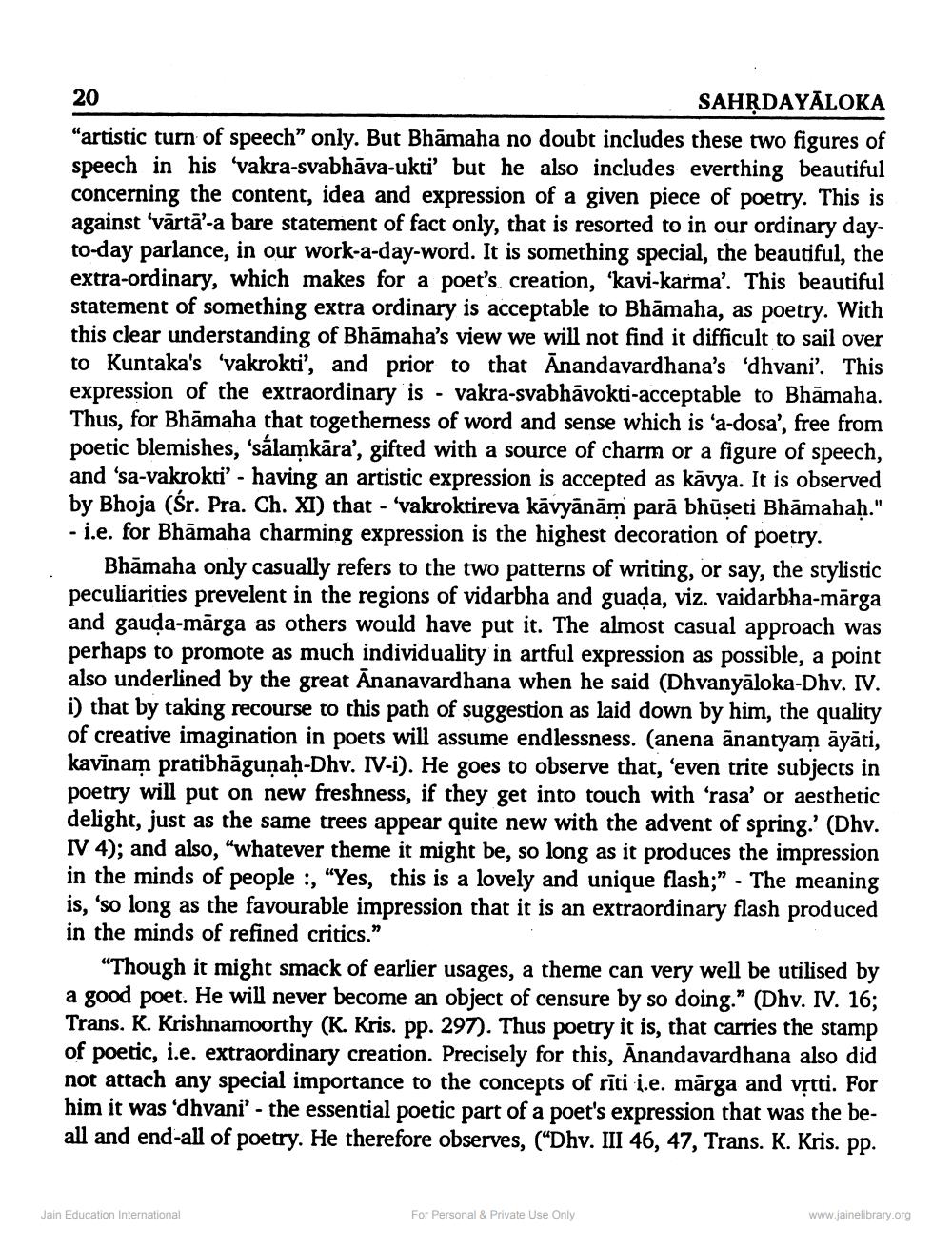________________
20
SAHRDAYĀLOKA "artistic turn of speech” only. But Bhāmaha no doubt includes these two figures of speech in his 'vakra-svabhāva-ukti' but he also includes everthing beautiful concerning the content, idea and expression of a given piece of poetry. This is against 'vārtā’-a bare statement of fact only, that is resorted to in our ordinary dayto-day parlance, in our work-a-day-word. It is something special, the beautiful, the
a-ordinary, which makes for a poet's creation, 'kavi-karma'. This beautiful statement of something extra ordinary is acceptable to Bhāmaha, as poetry. With this clear understanding of Bhāmaha's view we will not find it difficult to sail over to Kuntaka's 'vakrokti', and prior to that Anandavardhana's 'dhvani'. This expression of the extraordinary is - vakra-svabhāvokti-acceptable to Bhāmaha. Thus, for Bhāmaha that togetherness of word and sense which is ‘a-dosa', free from poetic blemishes, 'sálamkāra', gifted with a source of charm or a figure of speech, and 'sa-vakrokti' - having an artistic expression is accepted as kāvya. It is observed by Bhoja (Śr. Pra. Ch. XI) that - 'vakroktireva kāvyānām parā bhūseti Bhāmahah." - i.e. for Bhāmaha charming expression is the highest decoration of poetry.
Bhāmaha only casually refers to the two patterns of writing, or say, the stylistic peculiarities prevelent in the regions of vidarbha and guada, viz. vaidarbha-mārga and gauda-mārga as others would have put it. The almost casual approach was perhaps to promote as much individuality in artful expression as possible, a point also underlined by the great Ananavardhana when he said (Dhvanyāloka-Dhv. N. i) that by taking recourse to this path of suggestion as laid down by him, the quality of creative imagination in poets will assume endlessness. (anena ānantyam āyāti, kavīnam pratibhāguṇaḥ-Dhv. IV-i). He goes to observe that, 'even trite subjects in poetry will put on new freshness, if they get into touch with 'rasa' or aesthetic delight, just as the same trees appear quite new with the advent of spring.' (Dhy. IV 4); and also, "whatever theme it might be, so long as it produces the impression in the minds of people :, "Yes, this is a lovely and unique flash;" . The meaning is, 'so long as the favourable impression that it is an extraordinary flash produced in the minds of refined critics."
“Though it might smack of earlier usages, a theme can very well be utilised by a good poet. He will never become an object of censure by so doing." (Dhv. IV. 16; Trans. K. Krishnamoorthy (K. Kris. pp. 297). Thus poetry it is, that carries the stamp of poetic, i.e. extraordinary creation. Precisely for this, Ānandavardhana also did not attach any special importance to the concepts of rīti j.e. märga and vịtti. For him it was 'dhvani'- the essential poetic part of a poet's expression that was the beall and end-all of poetry. He therefore observes, (“Dhv. III 46, 47, Trans. K. Kris. pp.
Jain Education International
For Personal & Private Use Only
www.jainelibrary.org




